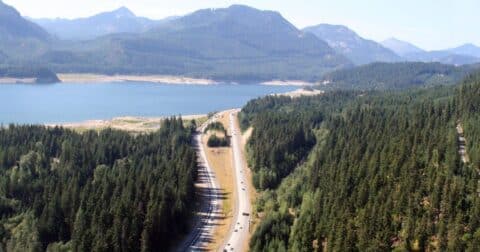Explainer
How Overconsumption Affects the Environment and Health, Explained
Climate•12 min read
Solutions
The once-treacherous Snoqualmie Pass is now safer for both wild animals and drivers.


Words by Marlena Williams
If you drive down Interstate 90 through Snoqualmie Pass in Washington state, there is a good chance an animal might be traveling above or below you. This busy travel corridor, heavily trafficked by motorists and fauna, is now home to an impressive network of wildlife crossings that safeguard the region’s biodiversity by providing animals safe passage across once-treacherous highways.
Motion-activated cameras stationed along these crossings have captured an exciting variety of species passing through them. A mother deer and her fawns bound beneath an underpass. A curious coyote sniffs his way along the passage before darting away into darkness. Two elk calves play on top of a bridge, seemingly unbothered by the mid-day traffic zooming beneath them.
The 15-mile Snoqualmie Pass East project consists of a variety of structures, including bridges, underpasses, culverts and fences, all designed to mitigate the harm that roads pose to animals. The centerpiece of this massive infrastructure plan is the Keechelus Wildlife Overcrossing, a 60-foot tall, 150-foot wide archway spanning six lanes of traffic and fully vegetated with flora from the surrounding forest. The overpass, which was completed in 2018, is Washington’s first-ever wildlife bridge over a highway and the largest such crossing in North America. Within a few years, researchers documented animals safely crossing 14,000 times.
Similar structures are sprouting up all across the country, from the traffic-clogged freeways of Los Angeles to the wide open stretches of Montana’s Big Sky region. Wildlife crossings offer a simple but effective solution for keeping wildlife safe, one that reduces traffic deaths, protects imperiled species and even shifts the way we think about roads and the animals that we share them with.
I-90 is the longest interstate in the country, beginning in Seattle and snaking through the entire northern United States to Boston. In Washington, the highway serves as a crucial travel corridor connecting the population centers of Western Washington to the many agricultural industries and recreational offerings of Eastern Washington. Farmers and growers in the Eastern part of the state rely on I-90 to bring their goods to market, while locals and tourists traverse the highway on their way to the countless hiking, skiing and nature destinations that cover the state.
The Cascades Range in Washington once formed one giant, connected ecosystem stretching from the lowland forests in the Puget Trough to the mountain lakes and alpine glaciers topping the state’s many iconic peaks. I-90 effectively sliced the Cascades in two, creating a unique migratory problem for the people and the animals that populate the state. As motorists freely speed east to west along I-90, the region’s wildlife found their natural north to south seasonal migrations stymied by the freeway.
An estimated 27,000 cars cross Snoqualmie Pass every day. These traffic levels essentially created a complete barrier for the abundance of wildlife that calls the region home: elk, wolverines, black bears, bull trout, river otters and cougars, to name but a few. Many of these species were left isolated on one side of the freeway or another, unable to cross what researchers call the “moving fence” of I-90 in search of food, shelter and mates. Those that did cross faced the very real threat of serious injury and death.
Environmentalists, biologists and wildlife advocates saw an opportunity to remedy the problem in the early 2000s, when the Washington Department of Transportation began planning a massive, $550 million construction project in Snoqualmie Pass, aiming to improve deteriorating road conditions, expand the lanes across I-90 and reduce congestion and road closures. Over 40 national and local organizations joined together to form the I-90 Wildlife Bridges Coalition, which has since become part of Conservation Northwest, to push for the addition of wildlife connectivity areas to the state’s infrastructure plan.
Most of the members of the coalition were the usual suspects: the Sierra Club, the Cascades Conservation Partnership, the Humane Society. However, groups like ski clubs and the also joined the coalition to make the roads safer and better for both humans and wildlife. By the time the state legislature approved funding for the crossings, there was a wellspring of support from all across the state. The coalition even sponsored a coloring contest in public schools, where students created their own imagined versions of the wildlife crossings and competed for a grand prize.
Snoqualmie East was modeled after the famous wildlife connectivity areas along the Trans-Canada Highway in Banff National Park, which is home to the most numerous and varied wildlife structures on the planet. To make the crossings a reality in Washington, the Department of Transportation worked closely with the U.S. Forest Service and several other state and federal agencies. University researchers and biologists flocked to the area to study the landscape and advise engineers on structure placement and design. Teams of volunteers and botanists came together to restore the habitat near roads, repairing the soils, planting food sources and creating natural structures to encourage critters to take shelter and move about.
Full construction of Snoqualmie Pass East won’t be completed until 2029, but the project is already showing promising results. Through July 2021, animals were documented successfully crossing the existing structures nearly 14,000 times. By the end of 2023, motion activated cameras had recorded over 25,000 safe animal crossings, which included 7,967 elk, 13,525 deer, 3,216 coyotes and 6 cougars.
Wildlife crossings are a relatively new phenomenon. Though the concept was first developed in France in the 1950s, and later popularized in the Netherlands and Canada, the United States did not begin regularly building such crossings until about twenty years ago. There are now estimated to be about 1,500 structures across 43 states. Most structures are largely clustered in Western states. Many of these projects, like Snoqualmie Pass, are ongoing. This means we are still developing and collecting comprehensive data about the long-term success of these structures on a wide scale. However, the data we do have points to the effectiveness of crossings across a number of metrics. In some places, wildlife crossings have reduced vehicle-wildlife collisions by as much as 97 percent.
Wildlife crossings are not without their limitations however, the most obvious of which is cost. Though costs vary widely project to project depending on the geography of the region and the type of structure being built, overpasses typically cost several million dollars each, and multiple structures together can run upwards of $50 million. The single wildlife bridge at Snoqualmie Pass alone cost $6.2 million dollars.
Because funding for these structures is often included as part of larger transportation and infrastructure budgets, competing priorities and declining revenues can mean less and less money is allocated towards crossings, if they are approved. What’s more, most stretches of highway are marked by a complicated patchwork of land ownership split between public, private and tribal groups, making it difficult for coalitions to form, especially in polarized local areas.
Though the unique coalitions in Washington made the Snoqualmie Pass an easy victory at the state legislature, these types of partnerships don’t exist everywhere, and limited funding may hold back similar projects. In 2021, Congress passed a massive infrastructure bill that allocated $350 million for the Wildlife Crossings Pilot Program, but advocates agree that this is a mere drop in the bucket compared to the huge amount of money needed for a truly effective nationwide connectivity system.
Getting funding for these structures is only the beginning. Building structures animals will actually use is the next hurdle, and the most important one. The best crossings are carefully designed to mimic and blend with the surrounding ecosystems, offering a seamless transition from forest to crossing, often including sound walls so animals will not be spooked by the thunderous sound of traffic above or below.
Wildlife crossings also need to be tailored to the species who use it. A successful crossing network may involve many different structures for many different species, or a few giant, complex structures that will appeal to many different species at the same time. While bigger animals like deer and bears tend to be the most obvious targets for such projects, Snoqualmie was careful to emphasize low-mobility species and small mammals as well, building structures that could be used by mice, voles, pika, western toad and the coastal giant salamander.
The bottom line: the work of a wildlife crossing doesn’t start and end with the road. Even after construction is complete, crossings require monitoring, management and maintenance to ensure that animals are actually using the passage. It can take months and even years for animals to acclimate to the new landscape. At Snoqualmie, only one cougar crossed the structure between 2014 and 2022, for instance. But that finally changed in 2023, as the wildlife crossing saw the cougars cross five times. Cougars are still crossing this year, the teams have noticed, which is good news for the cougars, and the other wildlife who use this passage.